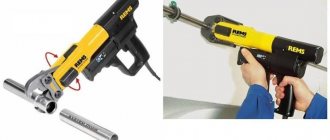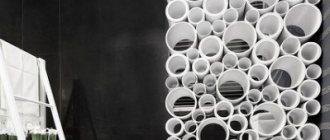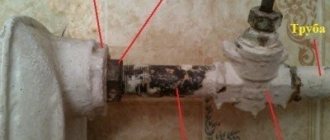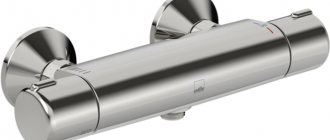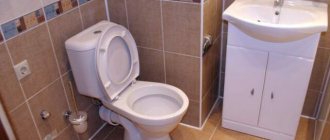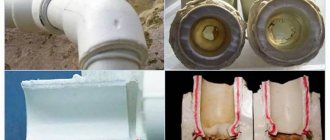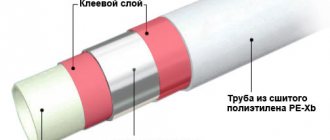Andrey
7788 0 0
Andrey July 31, 2016Specialization: facade finishing, interior finishing, construction of dachas, garages. Experience of an amateur gardener and gardener. We also have experience in repairing cars and motorcycles. Hobbies: playing the guitar and many other things that I don’t have time for :)
Often people who independently undertake the renovation of an apartment or house wonder about assembling pipelines from metal-plastic pipes. In reality, there is nothing complicated about this, however, like any other work, the installation of metal-plastic pipes contains its own nuances and subtleties. Therefore, below I will tell you in detail about all the methods for assembling a pipeline from “metal-plastic”.
Pipeline made of metal-plastic pipes
Rating of metal-plastic pipes
Manufacturers offer pipes of different diameters, find original design solutions, and use innovative and well-known materials. The VyborExperta.ru team selected well-known manufacturers, conducted testing, and compared the results obtained with the declared characteristics. Experts studied the range of fittings offered for installation of communications. When compiling the review, the opinions of professionals in the field of water supply and heat supply, feedback from users and property owners were taken into account.
During the analysis, attention was paid to the following parameters:
- Working pressure – determines the scope of application of the product;
- Temperature – indicators of constant and short-term load were considered;
- Bending radius – affects the complexity of installation in limited space;
- Linear expansion - affects performance characteristics;
- Inner diameter is the main indicator for calculating productivity;
- The thickness of the wall and the aluminum layer - affect strength and durability;
- Throughput - performance depends on the resistance of the internal surface to air flow or liquid.
Not all product series have been tested. Delamination when the temperature rises, a shortage of fittings on the market, mechanical damage on a new product - such products were excluded from the rating.
The best adhesives for plastic
Non-standard connections with metal pipes, transition to a different diameter
Repairing a water supply or heating system, if steel pipes were previously used, requires connecting metal and metal-plastic together. The metal pipe is cut, leaving 3-5 cm, and an external thread is made. The connection must be sealed. Wrap it in tow, smear paint or use fum tape.
A fitting that has a union nut or internal thread is screwed onto a metal pipe. Metal-plastic is fixed on the reverse side. The products are connected, the nut is tightened.
If the pipelines are of different diameters, installation is carried out in the same way. Just select an adapter fitting that has the appropriate dimensions. On one side there is a connector for metal-plastic, on the other there is a thread for a steel pipe.
The best metal-plastic pipes 16 mm
The small diameter makes these pipes suitable for the internal wiring of a small country house or apartment, for underfloor heating systems in the kitchen, bathroom or toilet. Product parameters do not allow manufacturers to use reinforced reinforcement and thick walls. For this reason, it is necessary to choose high quality products that can cope with the planned loads. The editors of VyborExperta.ru recommend products of three brands that have successfully passed tests, are made from high-quality raw materials and have an optimal thickness of the reinforcing layer.
Stout PE-Xb/Al/PE-Xb 20
The series was developed taking into account the specifics of operation in Russian conditions. The products can be used for drinking water supply, wall and floor heating. Transportation of glycol-based coolants is allowed. For the inner and outer layers, engineers chose mesh polyethylene, which is highly durable. The reinforcement thickness of 0.3 mm allows use at pressures of up to 10 atmospheres.
During production, special attention is paid to the quality of the glue and butt seam. This allows for reliability, shape stability, and reliable protection against oxygen penetration. Aluminum parameters are stable throughout the entire length of the pipe. The thickness of the inner layer of PE-Xb polyethylene is at least 2/3 of the wall thickness. The outer layer reliably protects the structure from mechanical damage and exposure to solar ultraviolet radiation.
Advantages:
- Maximum coolant temperature 100 ºС;
- Good plasticity simplifies installation and helps save on fittings;
- Resistant to aggressive chemical attack;
- Service life 50 years;
- Good throughput.
Flaws:
- Not detected.
For welding aluminum foil, a patented technology using tungsten in an inert gas environment is used. High quality welding limits the diffusion of oxygen from the external environment to the maximum and reduces linear expansion to a minimum.
Henco Standard (PE-Xc/AL/PE-Xc) 200216
When choosing a 16 mm metal-plastic pipe for underfloor heating, many designers choose products from the Belgian company Henco. A special feature of the product is a high-strength central layer made of thick aluminum foil, sewn using longitudinal seamless welding technology. It provides 100% protection against oxygen diffusion. The reinforcement provides a linear expansion coefficient similar to that of metal.
The inner and outer layers of PE-Xc polyethylene are cross-linked using electron beams. The material protects aluminum from mechanical stress. The inner layer is very smooth, which minimizes pressure loss. When laying heated floors, the pipes retain their shape after bending. This simplifies installation and reduces the consumption of fittings.
Advantages:
- Brass and polymer fittings are available;
- Strict quality control;
- Resistance to depressurization;
- The thickness of the reinforcing layer is 0.4 mm;
- No defects after bending.
Flaws:
- There are many fakes on the market.
Kermi Xnet MKV 20
The five-layer pipe of the German company was developed for underfloor heating systems. Recommended for installation in large areas. To make it easier for the master to work, there are markings on the coils indicating how much material is left at his disposal. Pipe DN16 is highly elastic. This ensures installation with minimal bend radii and allows the use of fewer attachment points.
The aluminum supporting layer provides 100% tightness and a linear expansion coefficient similar to metal. The inner layer is made of PE-RT polyethylene with a very low roughness coefficient. Working pressure at a temperature of 70 degrees can reach 10 atmospheres.
Advantages:
- Resistance to solar ultraviolet radiation;
- Light weight;
- Resistance to electrochemical influences;
- Availability of a proprietary system for laying heated floors;
- Wide selection of fittings.
Flaws:
- Overcharge.
Features of polymer products
As you know even from a school physics course, when substances are heated, they begin to increase in volume. This is directly related to plastic products, and the high temperature also makes them plastic.
When installing pipelines for cold water, you can not take into account the expansion coefficient (for more details: “Preliminary calculation of the thermal expansion of polypropylene pipes”). At the same time, when arranging the heating structure, this nuance must be taken into account.
It is this circumstance that raises doubts among many home craftsmen as to whether it is possible to wall up polypropylene pipes into the wall, which will begin to lengthen and expand when the hot pipeline is started.
This raises a logical question as to whether the finishing materials in which the elements of the engineering system are embedded will be damaged.
Experts assure that metal pipe products that expand slightly can simply be embedded in a layer of material, but in order to hide polypropylene pipes in the wall, you have to fully adhere to the technology of installation work (more details: “Types, properties, installation of propylene pipes with your own hands”) . Otherwise, the finishing of the room will become covered with cracks, and the tile covering will most likely fall off.
The best metal-plastic pipes 20 mm
I use pipelines with a diameter of 20 mm for internal distribution of hot and cold water supply in apartment buildings and commercial real estate. The pipes used in these systems must withstand high pressure and have reasonable flexibility. Our team recommends choosing products from well-known brands that will ensure reliable water supply. We invite you to pay attention to three series of metal-plastic pipes for water supply, which have a five-layer structure and are designed to operate at high pressure.
Valtec Pex-Al-Pex V2630
The Italian company is one of the world leaders in the composite pipes market. The manufacturer uses innovative technologies: welding of the reinforcing layer of aluminum with a non-consumable electrode in an inert gas environment, cross-linking of polyethylene using the organosilanide method. The result is products that meet GOST requirements and can withstand pressures of up to 10 atmospheres.
To reinforce Valtek metal-plastic pipes, 0.3 mm aluminum foil is used, which provides the necessary strength and flexibility, and minimal linear expansion. The inner layer is made of PEX polyethylene with low flow resistance. Two series of fittings have been developed for installation work.
Advantages:
- High resistance to delamination;
- Operating temperature 95 degrees;
- Withstands a brief increase in temperature up to 130 degrees;
- Manufacturer's warranty 10 years;
- Bend radius 45 mm.
Flaws:
- There are many fakes on the market.
Uni-Fitt Pro (PE-XC/AL/PE-XB) 26
Italian-made products stand out from competitors due to the increased thickness of the reinforcing layer. During production, 0.5 mm foil is used, which provides protection against oxygen diffusion and minimal linear expansion. The inner layer is made of cross-linked polyethylene PE-Xc, which has low resistance to transported media. The outer layer of PE-Xb provides reliable protection against mechanical stress.
The products are designed to operate under pressure up to 10 atmospheres, at a temperature of 95 degrees. Short-term temperature peaks of up to 110 degrees are allowed. The service life is determined to be 50 years with a ten-year guarantee class=”aligncenter” width=”1000″ height=”1000″[/img]
Advantages:
- Resistance to solar ultraviolet radiation;
- Practical packaging of coils;
- Delamination resistance;
- Zero diffusion of oxygen from the external environment;
- Branded fittings.
Flaws:
- Small bend radius.
Uponor Uni Pipe PLUS 25
The company, founded in Finland, has become a global holding company over half a century and produces products using innovative technologies. A seamless layer of extruded aluminum is used for reinforcement. The inner and outer layers are heat-resistant polyethylene PE-RT. Pipes are produced using the extrusion method, which eliminates the presence of seams. The products can be used for open and hidden installation water supply systems.
When choosing the thickness of the aluminum reinforcing layer, the company's engineers found a balance between strength and elasticity. The bending radius is 30-40% smaller than that of competitors, which allows saving up to 15% of fittings. The quality of the materials used eliminates the need to re-adjust the shape after bending, which has a positive effect on the speed of installation work.
Advantages:
- Low price of plastic fittings;
- Smooth inner surface;
- Delamination resistance;
- Original design of fittings for reliable installation;
- Zero diffusion of oxygen.
Flaws:
- Overcharge.
The best metal-plastic pipes 32 mm
Pipelines of this size are used for supplying water, as risers in a small country house, and in water supply systems. The versatility of use increases the requirements for the pipes and fittings used. Leading manufacturers take this into account and we recommend purchasing products only from well-known brands. Our team advises you to pay attention to two series of European manufacturers, which are distinguished by good technical characteristics and a long service life.
Uponor MLC S 40
Multilayer pipe for heating systems and drinking water supply is designed to operate under pressure up to 10 atmospheres. The inner and outer layers are made of heat-resistant polyethylene, which ensures stable operation at a temperature of 90 degrees. Reinforcement with longitudinally welded aluminum ensures no linear expansion and protection against oxygen diffusion. The high quality of the glue used ensures a service life of at least 50 years.
Can be used for hidden and internal installation. The white color fits harmoniously into the interior, and the lack of linear expansion helps save on mounting brackets. A distinctive feature is good flexibility. This is relevant for systems installed in rooms with complex layouts.
Advantages:
- Delamination resistance;
- Smooth inner surface;
- High quality fittings;
- Minimum bend radius.
Flaws:
- You can find fakes on the market.
Rehau Rautitan pink 40
This product line is designed for heating systems. Can be used to connect radiators, as risers, as heated floors in large rooms. In production, heat-resistant polyethylene is used, which is cross-linked using the peroxide method. A special feature of the material is its pink color, which emphasizes the scope of application of the products.
Pipeline installation work can be carried out at temperatures down to -10 ºС. A wide range of fittings has been developed for installation. The use of joining technology on a sliding sleeve makes it possible to eliminate the need for sealing rings and increase the reliability of the entire heat supply system.
Advantages:
- High impact resistance;
- Installation in a screed is allowed;
- Good resistance to aggressive chemicals;
- Service life 50 years;
- Withstands freezing.
Flaws:
- For use only with technical water.
A little about fittings and couplings
Installation of pipelines begins with design and drawing up layout diagrams of heating and plumbing fixtures. Next comes cutting pipes of various lengths, while the edges are straightened and cleaned. Typically, the following connection methods are used: compression, press fittings and crimp couplings.
Types of press models
Compression fittings consist of parts such as:
- Union.
- Split ring.
- Union nut.
When installing this way, you will need a wrench and care. The advantages of this method include simplicity, reliability, and the possibility of dismantling. If used parts are used, the sealing gaskets must be replaced.
Docking using press fittings is used quite often. Systems using such fasteners are laid in concrete or hidden in walls. Cheapness is the positive side of this issue, but repeated compression is impossible, and in addition, you need to use special equipment - press pliers, but they can be rented.
Crimp connection type
There are a variety of pipe fittings on sale today, as well as tools and parts. No special training is required to operate this equipment. You should strictly follow safety precautions, as with any electrical appliances, perform the work carefully, without neglecting the rules and instructions.
How to choose metal-plastic pipes
On the construction market you can buy products from any well-known European company. Before purchasing, you need to make sure that there are certificates of origin, as there are many counterfeit products. Once you are convinced of the quality, you should pay attention to the materials used in production and design features. The buyer must know exactly the purpose of the purchased product and the optimal diameter that will make the water supply or heat supply system work efficiently.
Purpose
Metal-plastic products are used for laying drinking and hot water pipelines and organizing heating systems. Unlike polypropylene pipes, the scope of application is limited to indoor spaces for the products of most manufacturers. In production, polyethylene with different characteristics is used. Not all types of this polymer are recommended for constant contact with drinking water. For water pipes, it is better to choose products made from PE-Xa or PE-Xb polyethylene.
Material
For hot water supply systems, it is recommended to use pipes with an inner and outer layer of heat-resistant polyethylene. The best parameters are for PE-Xa, which is cross-linked using the peroxide method. This is a dense material with good resistance to high and low temperatures, characterized by elasticity and wear resistance. The only drawback is the high price. PE-Xb polyethylene is cross-linked using the silane method; the material has an average density and a less uniform structure, which affects its elasticity. Products made from this polymer have a shorter service life, which is fully compensated by their low price.
Diameter
Manufacturers indicate the outer diameter; to calculate the inner diameter, it is necessary to subtract the thickness of the two walls from this figure. This parameter is of decisive importance when choosing products and determines the performance of the system. For heated floors in a country house, city apartment or small office, a DN16 pipe is suitable, which will provide good heat transfer and has a low price. For water distribution around the house or apartment, DN 20 and DN25 are used, and for connecting radiators - DN32.
Design
Metal-plastic pipes have a five-layer structure. The difference is in the thickness of the main layers and the types of polyethylene used. Most manufacturers use the same cross-linked polyethylene for the outer and inner layers. This simplifies the manufacturing process. More functional products have an inner layer optimized for their main purpose. The greater the thickness of the aluminum foil in the structure, the higher the strength.
Preparation for installation
A drawing is made in advance and the dimensions are indicated. Connecting elements are drawn on the branches and their parameters are written. Keep in mind that fittings for taps must have a thread at the end. They make a list and make purchases based on it - there is no point in purchasing expensive, redundant or unnecessary products. Pipes are purchased with a small reserve.
Tools
Before installation, metal-plastic blanks are cut at right angles. The most convenient way is to use a special cutter that looks like scissors. It forms the desired cutting angle - 90°. Can be replaced with a hacksaw and cut in a carpenter's miter box.
In addition, other tools are used:
- Calibrator. The main purpose of the tool is to restore the original shape of metal-plastic and align the edges. The ends are flattened after cutting, which complicates installation. It also serves to flare the pipe outward, which is necessary for installation.
- A countersink is a device used to remove chamfers and burrs, but if not available, clean it with sandpaper or a construction knife. Some calibrators are equipped with a special protrusion for chamfering, so they do without a countersink.
- Pliers - necessary for installing non-separable fittings.
For work you will also need adjustable wrenches, a hammer, and a screwdriver.
Preparation procedure
Preparation of metal-plastic pipes for installation.
Pipes are bought rolled into a ring. When starting installation, cut pieces of the required length, adding up to 15 mm to fit into the fittings. When using a saw, burrs remain on the edges, which are removed (they are gone after the cutter).
If a countersink is used, the outside is chamfered at the same time. Then the calibrator is driven into the cavity and turned. At the same time, the geometry is leveled and the edge is flared.
Remove the internal chamfer using a construction knife if the tool is without a special device.
How to level a piece of metal-plastic pipe
They first straighten it with their hands, but the perfect shape is not obtained - this is important for the open installation method. Use a simple device. Find a flat surface and wrap the piece in cloth. Roll it over the board to create an even piece.
Which metal-plastic pipes are better?
Which metal-plastic pipe is for heating and which is for supplying drinking water? Which manufacturer is more reliable, and which one should not be trusted for the life support system at home? Our team has understood these issues and recommends the following series of products from famous brands:
- Stout PE-Xb/Al/PE-Xb 20 – for internal wiring in a small country house;
- Kermi Xnet MKV 20 – for heated floors;
- Valtec Pex-Al-Pex V2630 – for wiring in a city apartment;
- Uponor MLC S 40 – for water supply systems of commercial facilities;
- Rehau Rautitan pink 40 – for connecting radiators and heated floors in large areas.
The service life of metal-plastic products is equal to the duration of operation of the house. Choosing the best pipes will help you forget about the need for scheduled repairs of water supply and heating systems.
Video
In this video, a specialist will share his knowledge and tell you how to install a home heating system with your own hands:
Today, water supply is produced using modern materials.
Metal-plastic pipelines have become a very popular option for using these products for cold and hot water supply, as well as heating. However, it is worth knowing that when installing metal-plastic pipes with your own hands, it will be appropriate to additionally install gearboxes. This type of pipe does not like pressure drops in the system; reducers equalize this pressure.
Water pipe routing diagram.
